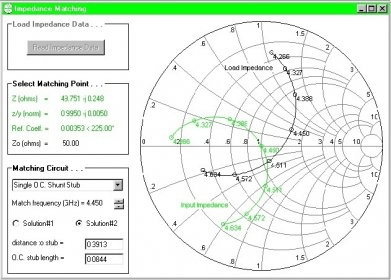

What I don't understand is, where is the reflection coefficient in any of this? If I understand the chart correctly, it basically maps the reflection coefficient for a normalized characteristic impedance to every possible (within reason) impedance (or conductance). If you need to match one impedance to another (one would be a conjugate), you simply identify the two impedances on the chart (normalized if necessary) and track a path between the two using the rules above. If you use a combined impedance and conductance chart you can easily model ladder networks, which of course is exactly what you need for an L, Pi or T matching network. Likewise, adding reactive elements in shunt can be achieved with the conductance form of the Smith Chart again using a simple addition or subtraction.
SMITH CHART IMPEDANCE MATCHING SERIES
The text points out that adding reactive elements in series with a resistor is a simple matter of adding the appropriate imaginary quantity, thus moving you along the constant resistance circle. He uses some of the earlier matching examples (solved using equations) and shows how the same result can be obtained using the Smith Chart. I've been reading the impedance matching chapter of Bowick's excellent RF Circuit Design book and I have a question.įor those who haven't read this book (or have but can't remember!), the chapter discusses L and 3 element matching networks (very intuitively, I might add) with some helpful examples before moving to an introduction to the Smith Chart.


 0 kommentar(er)
0 kommentar(er)
